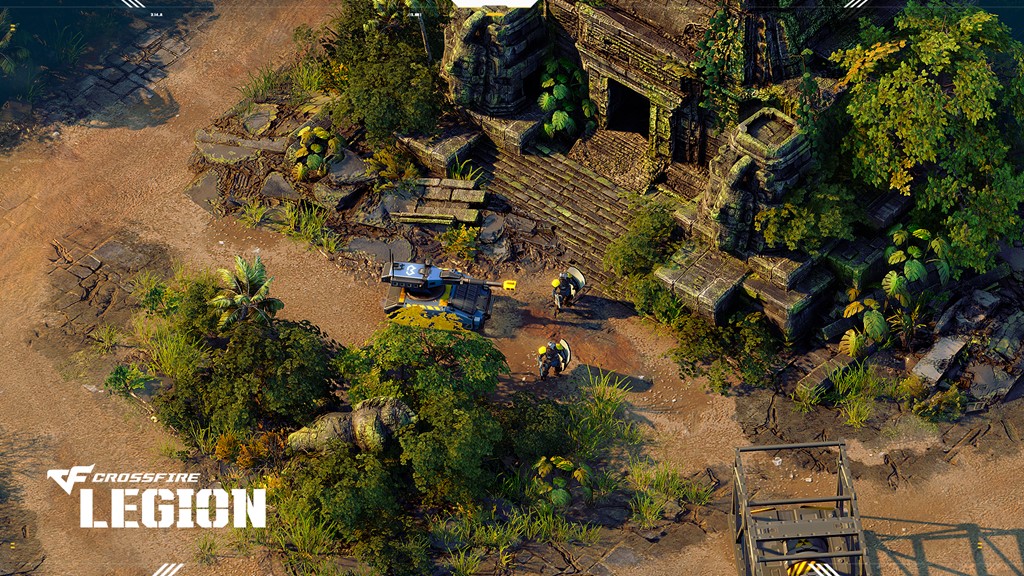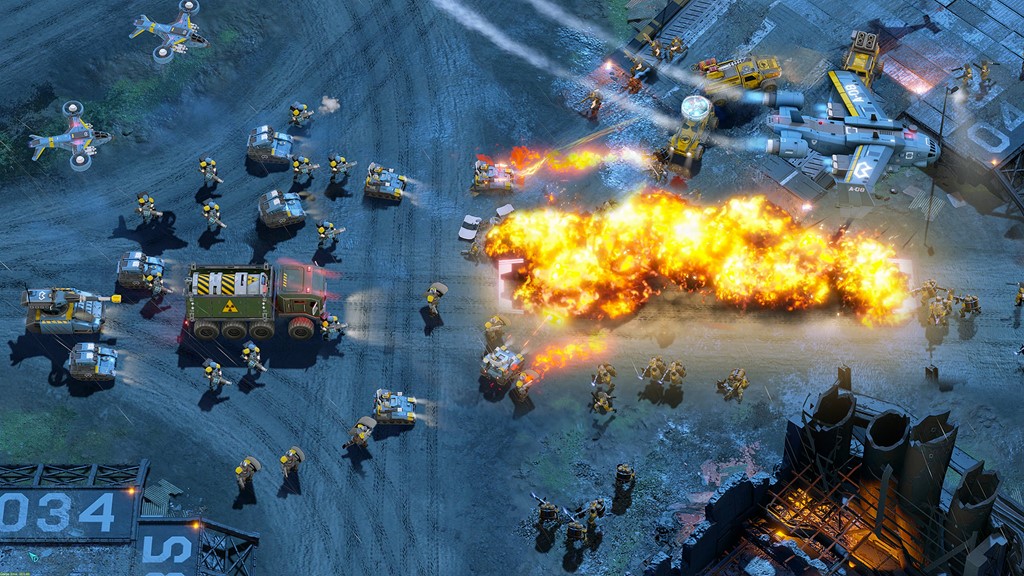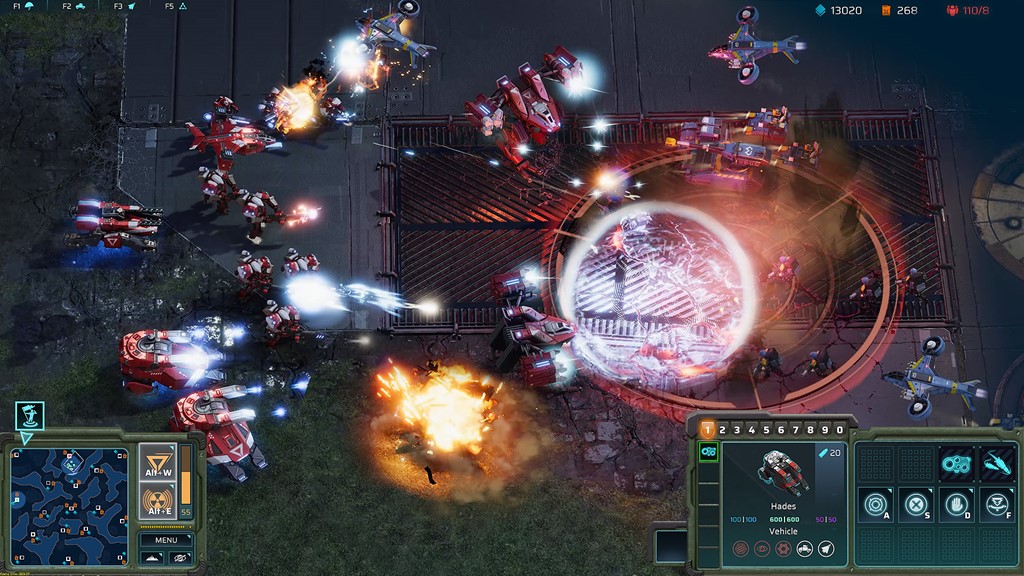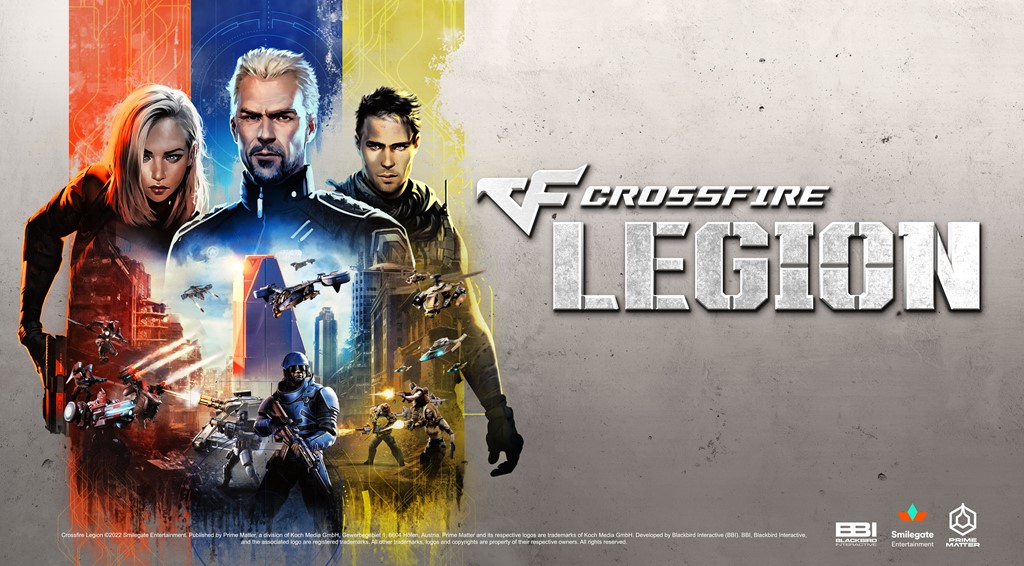Crossfire: Legion is an RTS from Blackbird Interactive and Prime Matter, a talented bunch who’ve published games like The Chant, Gungrave G.O.R.E. and Iron Harvest. Legion entered Steam’s early access in May 2022 and over time has had a wealth of content updates, fixes and feedback. Preparing for its full release on December 8th, the end product is the foundation of a solid and enjoyable – if simplistic – RTS title, but it falls victim to some significant shortfalls and friendly fire.
Triple The Faction
Similarly to Blackbird’s Iron Harvest and the now decades old Red Alert series, Crossfire: Legion is a more streamlined and accessible strategy title. There are 3 factions to select from: Black List, Global Risk and New Horizon. Each has their own unique units, active and passive abilities.
Aside from having the most generic and uninteresting names possibly ever given militaristic forces of warfare, the key characters and personalities attached to them are dull, mostly due to the flawed campaign experience.
In the run-up to release I was able to play through 12 of missions, with another 3 supposedly coming to tie up the narrative via a 4th act. Campaign missions are split into smaller, more linear types where you use the troops available to you and are reinforced when the mission decides, as well as more tactical variants that include base-building and unit development.
Well, it would be more tactical, if the mission structure had more variety. Most simply slap a timer on the screen in order to force you to bulldoze through an objective ASAP, making side-objectives utterly redundant as a result. For an example, one mission requires you to defend an on-rails mech as it proceeds through enemy checkpoints. You’re given a sub-objective to take down 6 enemy bases, only if you divert any of your forces from defending the mech it’ll get wiped out.
Consequently, you’ll just hoard up units and have them sit on the mech until the mission ends. There’s no reward or punishment as long as you complete the mission, making it feel superfluous to do anything else. This strategy of turtling, building up an army and then willfully launching straight at the enemy works far more effectively than it should, unfortunately.
The campaign certainly isn’t bad, it’s just lacking any real flair and it relies too heavily on artificial difficulties like timers or bottle-necking your progress instead of developing interesting or creative scenarios to challenge you. That said, there’s some great voice work in here (Ashly Burch and Elias Toufexis especially!) with some nicely animated cutscenes. If only the writing was a bit more adventurous.
It actually made me reminisce on the wackiness of Red Alert. Sometimes overly daft is better than dreary seriousness.

Wayward Aim
Crossfire: Legion’s campaign is largely there to teach you the basics of how to play and give you a chance to test out each faction and their abilities. While there are unique units and powers, all three feel pretty homogenous, with little variety in actual playstyle.
Base-building is as simple and straightforward as driving on an empty motorway. You have two resources that worker bots continuously mine, provided they aren’t destroyed. You can build a barracks, vehicle factory and aerodrome allowing you to produce 2-3 of their corresponding units and an upgrade for each. There are turrets used for base defence and on the multiplayer modes you need to build R&D centres for upgrades and unit population structures.
While the theory of Occam’s Razor is great and everything, it feels very light on any kind of strategic depth. Different varieties of troops, armour or flying mech have differing capabilities: a Minotaur may flatten infantry but a rocket trooper could decimate grounded and flying opponents alike. Most units have a unique active ability like a shield formation or a rocket barrage which you then deploy to turn the tide in your favour.
Balancing bigger, more powerful behemoths with smaller and more agile units is really the trick to success. Building up your army and unleashing abilities can be fun in more chaotic and bombastic engagements, but the core gameplay design has some inherent flaws that really detract from the experience.
Firstly, the pathfinding is pretty awful. Don’t be surprised to see groups of your most useful units twisting, turning and getting stuck amongst each other instead of actually battling off that army destroying your forward units. It’s like watching an ex-football player on Strictly Come Dancing kind of bad.
Secondly, the interface doesn’t give you access to all the tools you need quickly enough. If you’ve selected a group of different units (which you always will be), you can’t see all available abilities at once, only the one selected unit it decides you landed on first.
Icons for troops are tiny, meaning if you want to deploy a particular power promptly, you’ll be fumbling around trying to select them, by which time you’ve been blown apart. It creates some frustration and as a result, I largely didn’t bother to use most of them. If I have to battle the interface to use the fun and strategic part of the gameplay systems, then I’d rather just brute force my way to victory.

Legions Of Modes
Once you’ve seen through the roughly 5-6 hour campaign offering, you can head into Crossfire: Legion’s suite of multiplayer modes, of which there’s an impressive number. Unfortunately, there were no lobbies available for me to test my mettle against another like-minded commander, so the bots had to do.
Standard matches can go up to 3 vs 3, with each general vying for resource points and forward bases until the other players are eliminated. Additionally, there’s a Payload match type which has a smaller map and quicker engagement time. Battle Lines is an interesting mode with a macro focus: you deploy your forces, but they fight independently of you, first player to destroy the other’s HQ wins.
Lastly, there’s a cooperative 3 vs AI type, but I couldn’t try this one out unfortunately. The wealth of modes makes Crossfire: Legion a decent package overall, with the benefit of having smarter opponents to face off against in online arenas.
There’s a lot of content potential here, provided you can see past the flaws of the RTS mechanics and lack of depth in unit variety. One benefit of playing the multiplayer modes is the ability to select your favoured faction, general and unit types, which provides some scope for tinkering and experimenting to find your preferred way of making war.

Caught In The Crosshairs
Graphically, Crossfire: Legion is solid if unspectacular. There’s a good diversity of maps you’ll wage war across and unit designs are distinct and interesting. Battlefield effects like explosions, fire and abilities look great on the whole, while landscape and texture detail is well done.
Nothing here will particularly blow you away, but it looks good enough to keep you interested and engaged with the combat. As mentioned earlier, the audio and voice overlays are excellent, even if the writing itself is lackluster. It makes it that much more satisfying to witness your Titan mech obliterate enemies with a crescendo of missiles when they sound so satisfying.
Crossfire: Legion keeps up a steady framerate throughout, which is incredibly important when the action gets fired up and you’ve got dozens of units blasting each other at once. The UI and menus are smooth, as are the animations, even if some of said animations are unintentionally funny.
It does however, have some technical problems that have persisted through the extensive fixes and patches. One mission on the campaign failed me for completing the final objective – I don’t think I’ve ever had that happen before, who knew success could be so deflating? A quick reload sorted it but even so, weird bug to have.
I had troops regularly get stuck in geometry or breakdown harder than a terminator frozen with liquid nitrogen (if you don’t know that reference go watch Terminator 2 right now!) when the pathfinding simply gave up trying to sort itself out. They’re little persistent issues but enough of them happened that it did have a minor impact on the gameplay experience.
This isn’t uncommon for games coming out of early access, just be aware there’s still some edges to be ironed out in Crossfire: Legion.

Stuck In The Middle
Crossfire: Legion is a real mixed bag. On the one hand it has a cool visual style, great voice performances, decent RTS combat and a suite of modes to provide a lot of longevity. On the other however, it’s pinned down by a lack of gameplay depth, an underwhelming campaign, poor pathfinding issues and a lack of strategy-promoting design.
I enjoyed the primitive thrill of smashing my armies against my opponents, watching the carnage of destruction erupt around me before throwing up a new force to do it all again. The problem is, Crossfire: Legion only has a limited number of ways it can offer to wage war. The best of the genre offer tactical options and numerous strategies, all of which are equally viable and require a lot of thought to bring out satisfying problem-solving.
For most of my time with Crossfire: Legion however, I was required to think very little.
Crossfire: Legion is an accessible RTS with a decent foundation to become a great game, but it’s held back by a lackluster campaign, poor pathfinding and shallow strategic systems. A stellar voice cast, excellent graphical performance and primitively fun gameplay can carry you quite a way, but not enough to reach the best of the genre. Hopefully, there’s more to come.

Crossfire: Legion is launching on PC (review platform) on December 8th, 2022.
Developer: Blackbird Interactive
Publisher: Prime Matter
Disclaimer: In order to complete this review, we were provided with a promotional copy of the game. For our full review policy, please go here.
If you enjoyed this article or any more of our content, please consider our Patreon.
Make sure to follow Finger Guns on our social channels –Twitter, Facebook, Twitch, Spotify or Apple Podcasts – to keep up to date on our news, reviews and features.
